Automated project monitoring methods
| Line 13: | Line 13: | ||
Monitoring is a part of monitor and [[Project Control|control]] (M&E), an essential part in a project. Monitoring is collecting data to identify deviations in the planned project, in its scope, its budget, its schedule, the quality of work, the impact, the stakeholder’s requirements... [[Project Control|Control]] is taking corrective actions, following those deviations, in order to keep the project in track. Both actions are necessary to each other as monitoring without control would be useless, and control need a monitoring activity.<ref>Isaac, Shabtai, and Ronie Navon.(2014) [http://www.tandfonline.com/doi/abs/10.1080/01446193.2013.795653 "Can Project Monitoring and Control Be Fully Automated?"], Construction Management and Economics</ref> | Monitoring is a part of monitor and [[Project Control|control]] (M&E), an essential part in a project. Monitoring is collecting data to identify deviations in the planned project, in its scope, its budget, its schedule, the quality of work, the impact, the stakeholder’s requirements... [[Project Control|Control]] is taking corrective actions, following those deviations, in order to keep the project in track. Both actions are necessary to each other as monitoring without control would be useless, and control need a monitoring activity.<ref>Isaac, Shabtai, and Ronie Navon.(2014) [http://www.tandfonline.com/doi/abs/10.1080/01446193.2013.795653 "Can Project Monitoring and Control Be Fully Automated?"], Construction Management and Economics</ref> | ||
| − | + | ||
| + | [[File:msoftwares.png|thumb|Software tools used by US construction firms<ref>Peterson, F, Fischer, M(2009) [https://purl.stanford.edu/nc730zm7783 "Project Monitoring Methods Exploratory Case Analysis: Industry Responses"], CIFE</ref>]] | ||
While this article develops a certain emphasis on new informatic monitoring methods, it is important to keep in mind those recently developed tools aren’t yet widely used in the industry. It is understood due to a sector affinity that they are more used in software programming, while in USA’s construction projects 50% to 75% of professionals don’t use any software beside Microsoft office to monitor projects. <ref>Peterson, F, Fischer, M(2009) [https://purl.stanford.edu/nc730zm7783 "Project Monitoring Methods Exploratory Case Analysis: Industry Responses"], CIFE</ref> | While this article develops a certain emphasis on new informatic monitoring methods, it is important to keep in mind those recently developed tools aren’t yet widely used in the industry. It is understood due to a sector affinity that they are more used in software programming, while in USA’s construction projects 50% to 75% of professionals don’t use any software beside Microsoft office to monitor projects. <ref>Peterson, F, Fischer, M(2009) [https://purl.stanford.edu/nc730zm7783 "Project Monitoring Methods Exploratory Case Analysis: Industry Responses"], CIFE</ref> | ||
| Line 39: | Line 40: | ||
===Logical Framework Approach=== | ===Logical Framework Approach=== | ||
| + | |||
| + | IN CONSTRUCTION | ||
==Qualitative methods== | ==Qualitative methods== | ||
| Line 71: | Line 74: | ||
====Barcodes and RFID==== | ====Barcodes and RFID==== | ||
| + | [[File:mtools.png|thumb|Data collection tools used by US construction firms<ref>Peterson, F, Fischer, M(2009) [https://purl.stanford.edu/nc730zm7783 "Project Monitoring Methods Exploratory Case Analysis: Industry Responses"], CIFE</ref>]] | ||
Barcodes and RFID tags can also be used, in part of a broader organisation possibly involving operators and contractors. If possible, the systematic scan of a barcode/RFID tag on a project’s resource or raw material every time a stage of the project involving it, can easily be used to create a comprehensible overview of the project advancement, breakdown in multiples tasks. The use of such a system allow the breakdown of a project in the biggest possible number of small tasks without requiring more work to monitor each of these, as monitoring is done automatically, thus allowing a better viewing, and an effective control.<ref>Isaac, Shabtai, and Ronie Navon.(2014) [http://www.tandfonline.com/doi/abs/10.1080/01446193.2013.795653 "Can Project Monitoring and Control Be Fully Automated?"], Construction Management and Economics</ref> | Barcodes and RFID tags can also be used, in part of a broader organisation possibly involving operators and contractors. If possible, the systematic scan of a barcode/RFID tag on a project’s resource or raw material every time a stage of the project involving it, can easily be used to create a comprehensible overview of the project advancement, breakdown in multiples tasks. The use of such a system allow the breakdown of a project in the biggest possible number of small tasks without requiring more work to monitor each of these, as monitoring is done automatically, thus allowing a better viewing, and an effective control.<ref>Isaac, Shabtai, and Ronie Navon.(2014) [http://www.tandfonline.com/doi/abs/10.1080/01446193.2013.795653 "Can Project Monitoring and Control Be Fully Automated?"], Construction Management and Economics</ref> | ||
Revision as of 20:02, 18 February 2018
Abstract
Monitor and control is a vital part of a project, to make sure a project follow course according to scope deadlines and cost, there is a need to collect relevant information and analyse it. If there is any deviation to the established cost, schedule, or scope, the project manager and stakeholder can take the necessary actions to address the problem as fast as possible, thus safeguarding against further deviations.
This article only discusses the different processes and methods to monitor a project, to collect relevant data for further analysis, using automatic systems. Monitoring needs to be efficient and relevant, the kind of collected data varies widely from the kind of project (construction, software, research...) and from the way the project was planned.
Enabled by new technologies and to be more cost-effective, automatic data collection systems are increasingly becoming used in the industry and can supplement traditional processes. Project monitoring is therefore a rapidly evolving part of project managment.
Contents |
Monitoring in project managment
Monitoring is a part of monitor and control (M&E), an essential part in a project. Monitoring is collecting data to identify deviations in the planned project, in its scope, its budget, its schedule, the quality of work, the impact, the stakeholder’s requirements... Control is taking corrective actions, following those deviations, in order to keep the project in track. Both actions are necessary to each other as monitoring without control would be useless, and control need a monitoring activity.[1]
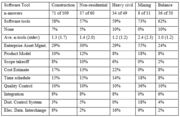
While this article develops a certain emphasis on new informatic monitoring methods, it is important to keep in mind those recently developed tools aren’t yet widely used in the industry. It is understood due to a sector affinity that they are more used in software programming, while in USA’s construction projects 50% to 75% of professionals don’t use any software beside Microsoft office to monitor projects. [3]
It is important to note monitoring can have some unexpected effects. Researchers in construction projects studied the behaviour of contractors when submitted with their performance assessment. Most contractors didn’t use the information to deliver the best possible work in the project, but instead adjusted their resources to provide a performance level as low as possible while guaranteeing future employment.[4]
Planning and monitoring
Project monitoring is strongly dependant on how the project was planned beforehand. Most project planning tools and techniques encompass a part of project monitoring, or at least give a frame to follow.
When monitoring a project according to a planning method, emphasis must be put in getting accurate information. The first thing to consider is the level of detail. A field report need to be made in accordance with the level of detail that was used in planning, if the information is more precise, it is then useless, if it is too broad, it can’t be comparable with the original plan. The complex time dimension should also be considered. The consumption of resources by an activity is not linear in time and can be very segmented and uneven across its duration. This repartition of resource consumption within an activity should be taken into account to avoid inaccurate conclusions. [5]
Work Breakdown Structure
Work Breakdown Structure (WBS) is a common system to organize project in the planning phase. In WBS work item are defined in term of cost and time, and each of these work item upon completion induces an accurate report. Therefore, WBS is a planning project system that already provides a framework for project monitoring. [6]
Kaban Approach
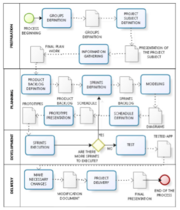
Kaban approach to plan and monitor a project is a scheduling system that allow visualization of workflows and progress of the project. Online Kaban tools developed using Business Process Model and Notation have therefore been developed as a way to monitor projects. As Kanban include a time dimension it is useful to monitor deadlines and delays. When fragmenting the project in different tasks, the greater the number of small tasks and artefacts, the more effective the monitoring tool will be. However, such a tool is useful to monitor project progress, but can’t monitor individual performances.[8]
PERT
PERT is yet another widely used planning method in project management. Computer programs using PERT to provide effective planning monitoring and control can reschedule a project, monitor the workplan trough an associated supervisor, handle multiples start and end dates and assess the time impact of deviations in the original plan. Such tools provide a better visualization of the critical path and different event dates scheduling the project with PERT and handle its modification when an unexpected event occurs. [9]
Logical Framework Approach
IN CONSTRUCTION
Qualitative methods
Indicators
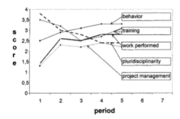
In long-term projects, or project without a clearly defined, identifiable or appreciable outcome, monitoring can be done using indicators. An indicator can give a precise or overall, but always customized and thus appropriate information about a project. Several indicators can be issued in the different stages of the project. An indicator can be used to report keep a stakeholder informed with a comprehensive overview or give a precise understanding of certain aspects to a manager. It is designed to give suitable information related to a certain topic, keeping in mind the objective, what appropriate information can be determined necessary to build it, and it must be calculated in a way to reflect the importance of the different information and assessments. Information is generally complex enough to be gathered by inspections during project development, and from different reports surveys conducting with workers and/or contractors.[11]
An indicator should be effective to allow the best understanding of project performances, concise to be focused on its subject, simple to reflect reality, visual to show tendencies within project progress, understandable and transparent in its elaboration.[12]
Report data mining
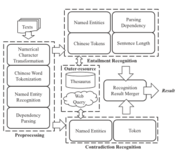
As said before, most project management methods, such as Earned value management-based methods require the production and evaluation of long and complex periodically written reports. However, analysing those reports take time, and conclusions are not easily reachable because written language is hard to quantify. That why tests have been made to develop text mining methods. It uses language processing techniques in order to evaluate the level of project completion. The ability to recognize textual entailment in progress reports can allow the manager to evaluate the performance of project members while reducing costs and workload.[14]
Quantitative methods
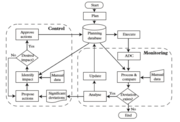
Classic monitoring methods, followed manually, are labour intensive, infrequent and can incur errors. When it finds deviations from the planned performance, it’s often too late to allow the best control. [16] . Those flows and available technologies allowed a drive in developing automated monitoring methods based on gathering as much data as possible.
GPS and sensors
Modern technologies can be used to gather as much data as possible, an information system can then organize those data in a usable tool to identify deviations from the original project plan. Those technologies are cheap, reliable and effective methods to gather precise of data. A commonly used tool is GPS, GPS technologies (or sensors) can be used to track the geographical position of resources in a project. The information can be used to track the use of materials, machines, vehicles, workers, shipments, operators … depending of the kind of project. To have a geographical overview of all the resources involved in a project can be useful to a project manager looking to optimize a project schedule, or spot difficulties in the planned schedule. An information system coupled with GPS data intake can determine at any moment if any machines or worker leave the spatial environment in which he is supposed to be in order to work on the planned unfolding of the project, thus noticing in real time a project manager of a deviation in the original plan. [17]
In a similar way, to monitor the accomplishment of different stages in a project, recent technologies allow the complex analysis of video recordings. Modern software can be used to automatically extract from a video information about the accomplishment of certain tasks. For example video recording can be used to know the actual time that workers spend carrying out activities and identify planning or productivity problems. [18]
Barcodes and RFID
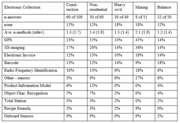
Barcodes and RFID tags can also be used, in part of a broader organisation possibly involving operators and contractors. If possible, the systematic scan of a barcode/RFID tag on a project’s resource or raw material every time a stage of the project involving it, can easily be used to create a comprehensible overview of the project advancement, breakdown in multiples tasks. The use of such a system allow the breakdown of a project in the biggest possible number of small tasks without requiring more work to monitor each of these, as monitoring is done automatically, thus allowing a better viewing, and an effective control.[20]
Data mining
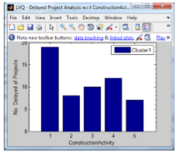
As an example of automatic processing data technique Learning Vector Quantization can be used with data mining in order to create clusters of project data and creating a visual overview where it is possible to identify disparities in different project stages or areas. [22]
Limitations
There are, however, several technical limitations in existing automated data collection techniques. Captors and chips can’t be used to collect any kind of data, and some information are still needed to be controlled by humans. It is especially hard to monitor human work efficiency, human actions requiring human knowledge and judgement to be assessed. Another issue linked to automated data acquisition lie in the monitoring frequencies of each techniques. Simultaneously using different automatic information flows to monitor a project can incur errors as some information is gathered in real-time, while some other is gathered in a periodic manner.[23]
References
- ↑ Isaac, Shabtai, and Ronie Navon.(2014) "Can Project Monitoring and Control Be Fully Automated?", Construction Management and Economics
- ↑ Peterson, F, Fischer, M(2009) "Project Monitoring Methods Exploratory Case Analysis: Industry Responses", CIFE
- ↑ Peterson, F, Fischer, M(2009) "Project Monitoring Methods Exploratory Case Analysis: Industry Responses", CIFE
- ↑ Wong P.S.P., Cheung S.O.,Wu R.T.H.(2009) "Learning from project monitoring feedback: A case of optimizing behaviour of contractors", International Journal of Project Management
- ↑ Li, Xiaoguang, and Lixia Wang.(2014) "Research on Important Process of Project Monitoring and Control", Advanced Materials Research
- ↑ Li, Xiaoguang, and Lixia Wang.(2014) "Research on Important Process of Project Monitoring and Control", Advanced Materials Research
- ↑ Miura Machado, Heydi, Alexandre L'Erario, Alessandro Duarte.(2017) "An analysis of Kanban as a project monitoring tool in undergraduate courses", Ieee Frontiers in Education Conference (fie)
- ↑ Miura Machado, Heydi, Alexandre L'Erario, Alessandro Duarte.(2017) "An analysis of Kanban as a project monitoring tool in undergraduate courses", Ieee Frontiers in Education Conference (fie)
- ↑ Johnson. (1964) "PERT/PMD - Project monitoring device", Ieee Transactions on Engineering Management
- ↑ Biguan M., Craye E. (2000) "Project Monitoring in a Graduate Engineering School", Ieee Transactions on Systems Man and Cybernetics
- ↑ Biguan M., Craye E. (2000) "Project Monitoring in a Graduate Engineering School", Ieee Transactions on Systems Man and Cybernetics
- ↑ Biguan M., Craye E. (2000) "Project Monitoring in a Graduate Engineering School", Ieee Transactions on Systems Man and Cybernetics
- ↑ Chang Y.C., Shih C.W., Hsu W.L. (2017) "Entailment-Based Intelligent System for Software Project Monitoring and Control", Ieee Systems Journal
- ↑ Chang Y.C., Shih C.W., Hsu W.L. (2017) "Entailment-Based Intelligent System for Software Project Monitoring and Control", Ieee Systems Journal
- ↑ Isaac, Shabtai, and Ronie Navon.(2014) "Can Project Monitoring and Control Be Fully Automated?", Construction Management and Economics
- ↑ Isaac, Shabtai, and Ronie Navon.(2014) "Can Project Monitoring and Control Be Fully Automated?", Construction Management and Economics
- ↑ Isaac, Shabtai, and Ronie Navon.(2014) "Can Project Monitoring and Control Be Fully Automated?", Construction Management and Economics
- ↑ Isaac, Shabtai, and Ronie Navon.(2014) "Can Project Monitoring and Control Be Fully Automated?", Construction Management and Economics
- ↑ Peterson, F, Fischer, M(2009) "Project Monitoring Methods Exploratory Case Analysis: Industry Responses", CIFE
- ↑ Isaac, Shabtai, and Ronie Navon.(2014) "Can Project Monitoring and Control Be Fully Automated?", Construction Management and Economics
- ↑ Riaz M. N., Husain S. A. (2012) "Intelligent Decision Support System for Construction Project Monitoring", 15th IEEE International Multitopic Conference
- ↑ Riaz M. N., Husain S. A. (2012) "Intelligent Decision Support System for Construction Project Monitoring", 15th IEEE International Multitopic Conference
- ↑ Isaac, Shabtai, and Ronie Navon.(2014) "Can Project Monitoring and Control Be Fully Automated?", Construction Management and Economics